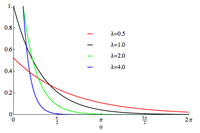Wrapped exponential distribution

Okay, imagine you have a bunch of toys in a bag, and you want to know how long it will take you to pull out a certain toy, let's say a teddy bear. A wrapped exponential distribution helps you figure out how long you'll be digging around in the bag before you finally find that teddy bear.
An exponential distribution is like a map that tells you how long it takes for something to happen. In our case, it tells us how long we'll keep pulling toys out of the bag before we finally find the teddy bear. The wrapped part of this distribution means that if we don't find the teddy bear in our first round of searching, we'll start again at the beginning of the bag and keep searching until we find the teddy bear.
Let's say the average time it takes to find the teddy bear is 2 minutes, according to our exponential distribution. Now, let's say we don't find the teddy bear in the first 2 minutes of searching. We'll start again at the beginning of the bag and keep searching. If it takes us another 1 minute to find the teddy bear, we'll add that to our original 2 minutes, so it took us a total of 3 minutes to find the teddy bear.
The wrapped exponential distribution helps us figure out the total time it will take us to find the teddy bear, even if we have to start our search over again multiple times. It's like a game of hide and seek, where we keep searching until we finally find what we're looking for.
An exponential distribution is like a map that tells you how long it takes for something to happen. In our case, it tells us how long we'll keep pulling toys out of the bag before we finally find the teddy bear. The wrapped part of this distribution means that if we don't find the teddy bear in our first round of searching, we'll start again at the beginning of the bag and keep searching until we find the teddy bear.
Let's say the average time it takes to find the teddy bear is 2 minutes, according to our exponential distribution. Now, let's say we don't find the teddy bear in the first 2 minutes of searching. We'll start again at the beginning of the bag and keep searching. If it takes us another 1 minute to find the teddy bear, we'll add that to our original 2 minutes, so it took us a total of 3 minutes to find the teddy bear.
The wrapped exponential distribution helps us figure out the total time it will take us to find the teddy bear, even if we have to start our search over again multiple times. It's like a game of hide and seek, where we keep searching until we finally find what we're looking for.
Related topics others have asked about:
